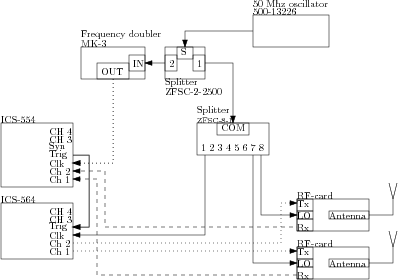Radar-system
The radar-system uses only one radio-platform, and the setup is similar to <ref>sub:Radio-system</ref>.
Hardware-setup
For this setup, the duplicator is not needed, and only two RF-cards are necessary. Align the two antennas, so that they point in the direction of the object. If possible, the player should be behind the antennas, so that his movement is hidden to the radar. Else it is difficult to tell apart the movement of the player with the movement of the object.
 |
|
Radar-system
(radar-setup.ps) |
Software-setup
Be sure to have the correct code loaded into the FPGA, else refer to <ref>sec:FPGA</ref> on how to program the correct code.
When everything is set up, you can start the radio on the software-platform:
cd $SRADIO/Test/Radar make rf_tail
Then, on a computer connected to the software-platform, connect the camera, make sure it is detected, and run:
cd $SRADIO/Tools/PlayRadar ./run
Eventually you have to adjust the following two variables:
- REMOTE
- points to the software-radio platform
- RADIO_DIR
- is the remote directory
Camera-setup
For this radar-system you can have a camera attached to the computer, so that the different people using the system can be shown live! Unfortunatly, this requires some setup to your computer. The source code for the driver can be found under:
http://www.saillard.org/linux/pwc/debian/
and once it is installed, things should run nicely.
Amplitude settings
The amplitude settings are done in case the two antennas are 1m apart and on the same height, pointing in the same direction. If you chose to use them in a different setting, it can be necessary to adjust the values attn_rx and attn_tx in the file \$SRADIO/Test/Radar/test_radar.c to more convenient values. Lower values mean lower attenuations. So if you put the antennas further apart, it may be useful to chose a lower value for attn_rx.
You can also run
cd \$SRADIO/Test/Radar make rf_show
and use the configuration-window from the radar_rf-module while looking at the output of radar_rf and the fft-stats of the radar_fft-module. Once you find a good pair of values where the output shows a dotted circle and the fft shows a clean peak, copy these values to test_radar.c and re-run it.